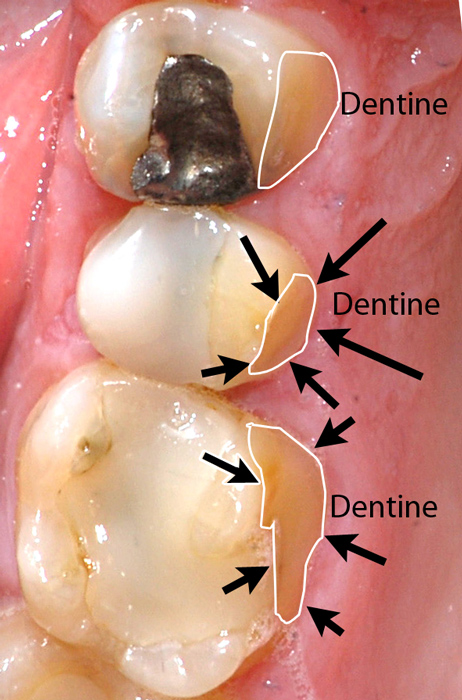Soft drinks and tooth enamel erosion
Here are the teeth of a man who drank 4 to 5 cans of soft drinks every day for several years. He was keeping each sip for 15 to 20 seconds in his mouth between his tongue and his palate before swallowing. The arrows indicate the surfaces where the enamel is practically all gone. It was dissolved. The dentin is what we see that is more yellow. Dentin is softer than enamel, because it contains less hydroxyapatite. Dentin is more sensitive to caries and wear. Notice also the very large restorations (fillings) on the molars and premolars showing the repair of large caries.
A close-up view puts in evidence the surfaces of dentin seen under the thin layer of remaining enamel, if some remains. The first tooth from the top shows an amalgam. The second one shows a restoration of more than half of the tooth using esthetic filling material. We can notice on the third tooth the edge of the composite filling.
The intake of soft drinks increases during hot summer days. Sugar-sweetened juices and energy drinks are a bigger part of the diet of young and not so young people at the cost of a simple glass of sugar free, acid free and calorie free water.
While the media focuses on the risks of obesity and diabetes with the intake of soft and sugar-sweetened drinks, it is important to realize that drinking soft drinks (Coke, Pepsi), sports drinks (Gatorade, Powerade), energy drinks (Red Bull, Monster) and other sugar-sweetened juices contributes to dental carie, dental pain and enamel erosion.
Clinical characteristics of dental erosion
Enamel erosion means dissolution of enamel that covers the teeth. Dental erosion is thus defined as the loss of dental hard tissue by a chemical process that does not involve the influence of bacteria.
Intrinsic factors associated with erosion are found in people suffering from eating disorders, such as bulimia and those who suffer from gastroesophageal reflux disease, vomiting or regurgitation. Acidic stomach content will get in contact with the teeth and these people will see that their enamel is destroyed.
The exaggerated intake of lemons will have the same effect. I already had the opportunity to treat a nun who was telling me about how much she loved to eat natural lemons. Let me tell you that she practically no longer had enamel on any tooth. She only had stumps of dentin!
According to the California Center for Public Health Advocacy, the average American drinks 50 gallons of soft drinks and sugar-sweetened drinks each year.
Bacteria feed themselves with what we ingest and drink and especially with sugar contained in foods that they eat and convert into acidic products which dissolve tooth enamel and remove the minerals that protect from caries.
If, in addition to that, we add extrinsic factors, such as the intake of lemons, soft drinks and other sugar-sweetened or energy drinks, these acidic drinks will facilitate dissolution of enamel even more easily.
A neutral pH is 7. Any measure lower than 7 indicates an acid pH. Enamel erosion is possible if the oral pH is lowered to 5.5.
A recent study measured the bacterial plaque pH variation after ingesting regular soft drinks, energy drinks and diet soft drinks. Twenty (20) minutes after ingesting only 15 mL (1 table spoon) of beverage, the pH was 2.65 for a regular soft drink, 3.39 for an energy drink and 3.78 for a diet soft drink.
Imagine the effect of a 355-mL can consumed over a 60-minute period. Imagine the effect of 2 cans during an afternoon. Imagine the effect of a 2-litre bottle… Imagine that you keep each sip in the mouth during 20 seconds.
How to protect ourselves from erosion
Saliva is the best protection from erosion. Washing of ingested acidic products is done by the saliva produced by our salivary glands and by how easy it is for us to swallow. A dry mouth facilitates erosion, because the pH cannot be reduced by saliva.
Drink water regularly. Water does not contain sugar, acidic products or calories. Water will keep the gingiva hydrated and will rinse food particles that would otherwise stay in the mouth.
Brush the teeth for 2 minutes after each meal and before going to bed. Use fluoride toothpastes. Use dental floss each day in the morning and before going to bed.
Recommended reading
The best article that I could find on the subject is Dental Erosion and Its Growing Importance in Clinical Practice: From Past to Present I recommend it. Images that you will find in it are worth a thousand words.
Dental Plaque pH Variation with Regular Soft Drink, Diet Soft Drink and High Energy Drink: An in vivo Study.
Jawale BA, Bendgude V, Mahuli AV, Dave B, Kulkarni H, Mittal S.
J Contemp Dent Pract. 2012 Mar 1;13(2):201-4.On dental erosion and associated factors.
Johansson AK.Swed Dent J Suppl. 2002;(156):1-77.
Dental Erosion and Its Growing Importance in Clinical Practice: From Past to Present
Ann-Katrin Johansson ,* Ridwaan Omar, Gunnar E. Carlsson, and Anders Johansson
Int J Dent. 2012; 2012: 632907.
Published online 2012 March 7. doi: 10.1155/2012/632907
PMCID: PMC3312266

 (1 votes,
(1 votes, 

Ask a question or leave a comment (0)